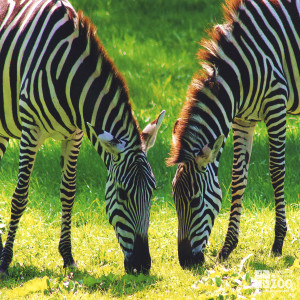Grant's Zebra
[Equus burchellii boehmi]

Grant's Zebra has short, narrow ears and stands at 50 to 55 inches. The weight is from 500 to 700 pounds. The upright mane is of stiff hair. The legs are striped to the hooves. Broad, oblique stripes on the hindquarters are less numerous near the belly, and there is no grid-iron pattern at the base of the tail where the stripes are longitudinal. Stripes are brownish to black. Foals have coarser coats, especially in the back. Zebras have one functional toe on each foot, the middle one.
Location: Animals Formerly at Zoo
Share:
Range
Grant's Zebras range includes Ethiopia, Somalia to northern South Africa.
Habitat
Grant's Zebras inhabit open grassy plains and well-grassed woodlands.
Conservation Status
Near ThreatenedPrimary Threats
Human Wildlife Coexistence, Climate ChangeGestation
12 months
Litter
1
Behavior
Grant's Zebras live in family groups of 5 to 20, but in the dry season they assemble by the hundreds, joining other ungulates. Mainly grazers, they do browse on leaves and scrub at times. In the dry season they dig for roots and rhizomes. They are highly dependent on water and do not leave water holes for very long. They usually drink daily. In the dry season they may wander great distances seeking water. In the northern part of their range they overlap with Grevy's Zebra, but the two do not hybridize.
Reproduction
Grant's Zebra stallions fight fiercely by kicking and biting during rutting. Mares are grouped together by a lead stallion to form a family herd. Mares have two inguinal teats, and their milk is rich in lactose. Foals suckle until 5 to 8 months of age. Adolescent mares leave the family group when they reach sexual maturity, either forming new herds or joining old ones. Adolescent stallions leave sometimes before maturity and either form or join bachelor groups.
Wild Diet
Grasses, leaves, scrub, rhizomes, corms
Zoo Diet
D&H pellets, hay, vitamins
